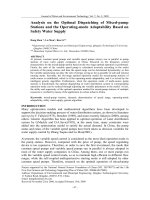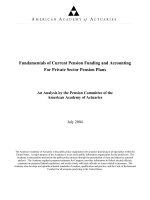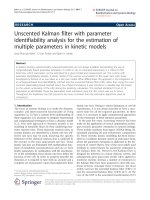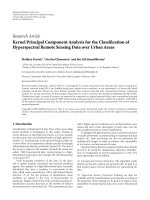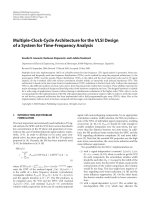Genome based analysis for the bioactive potetial of streptomyces gilvosporeus strain f607
Bạn đang xem bản rút gọn của tài liệu. Xem và tải ngay bản đầy đủ của tài liệu tại đây (2.66 MB, 60 trang )
VIETNAM NATIONAL UNIVERSITY OF AGRICULTURE
FACULTY OF BIOTECHNOLOGY
GRADUATION THESIS
TITLE
GENOME-BASED ANALYSIS FOR THE BIOACTIVE
POTENTIAL OF STREPTOMYCES GILVOSPOREUS
STRAIN F607
HANOI – 2021
VIETNAM NATIONAL UNIVERSITY OF AGRICULTURE
FACULTY OF BIOTECHNOLOGY
GRADUATION THESIS
TITLE:
GENOME-BASED ANALYSIS FOR THE BIOACTIVE
POTENTIAL OF STREPTOMYCES GILVOSPOREUS
STRAIN F607
Student
: VU NGAN HA
Department
: Biotechnology
Supervisor
: Dr. Dinh Truong Son
HANOI – 2021
COMMITMENT
I hereby declare that this is my research work. The figures and image results, which
presented in the thesis, are truthful and have not been published in other scientific studies.
I hereby certify that all information and references in this thesis have been clearly
originated.
Hanoi, February 24th, 2021
Student
Vu Ngan Ha
i
ACKNOLEDGEMENTS
The topic " GENOME-BASED ANALYSIS FOR THE BIOACTIVE POTENTIAL
OF Streptomyces gilvosporeus strain F607" is the content that I choose to do research and
graduate thesis after four years at Faculty of Biotechnology, Vietnam National University
of Agriculture. During my graduation thesis, I have received a lot of help to complete my
thesis.
First of all, I would like to sincerely thank Dr. DINH TRUONG SON, who
enthusiastically guided, encouraged and helped me throughout the research process for
me to complete this thesis. Besides, I would like to sincerely thank teachers in the at the
Laboratory of Department of Plant Biotechnology, Faculty of Biotechnology for their
valuable comments on the thesis.
On this occasion, I would also like to thank the Department of Plant Biotechnology,
the Faculty of Biotechnology, Vietnam National University of Agriculture, for creating
conditions and time for me throughout the research process.
Finally, I would like to thank my relatives and friends who have always been by my
side, encouraging me to complete this course and essay.
Hanoi, February 24th, 2021
Student
Vu Ngan Ha
ii
CONTENTS
COMMITMENT .................................................................................................................. i
ACKNOLEDGEMENTS .................................................................................................... ii
LIST OF ABBREVIATIONS ............................................................................................. v
LIST OF TABLES ............................................................................................................. vi
LIST OF FIGURES ........................................................................................................... vii
ABSTRACT ....................................................................................................................... ix
PART 1. INTRODUCTION ................................................................................................ 1
PART 2. LITERATURE REVIEW ..................................................................................... 2
2.1. The genus Streptomyces ............................................................................................... 2
2.1.1. General characteristics of Streptomyces .................................................................... 2
2.1.2. Morphological development of Streptomyces ........................................................... 4
2.2. Secondary Metabolites from Streptomyces .................................................................. 6
2.3. Introduction to Ficellomycin ........................................................................................ 9
2.4. Bioinformatics software ............................................................................................. 11
2.4.1. Blast2Go .................................................................................................................. 11
2.4.2. antiSMASH ............................................................................................................. 13
PART 3. MATERIALS AND METHODS ....................................................................... 14
3.1. Study laboratory and time .......................................................................................... 14
3.2. Materials ..................................................................................................................... 14
3.3. Methods ...................................................................................................................... 14
3.3.1. Identification, functional annotation and analysis the S. gilvosporeus strain F607 15
3.3.2. Secondary metabolite biosynthesis gene cluster prediction .................................... 15
PART 4. RESULT AND DISCUSSION........................................................................... 16
4.1. General genomic features of S. gilvosporeus strain F607 .......................................... 16
4.2. Molecular characteristic related to the whole - genome of S. gilvosporeus F607 ..... 19
4.3. Functional Annotation ................................................................................................ 22
4.4. Biosynthetic gene clusters for secondary metabolites of strain F607 ........................ 29
4.5. Proposed biosynthetic pathway of ficellomycin from S. gilvosporeus strain F607 ... 33
iii
PART V. CONCLUSION AND SUGGESTION ............................................................. 39
1. Conclusion ..................................................................................................................... 39
2. Suggestion ..................................................................................................................... 39
REFERENCES .................................................................................................................. 40
APPENDIX ....................................................................................................................... 44
iv
LIST OF ABBREVIATIONS
Abbreviations
Definition
NCBI
National Center for Biotechnology Information
COG
Clusters of Orthologous Genes
rRNA
Ribosomal ribonucleic acid
tRNA
Transfer ribonucleic acid
BGCs
Biosynthetic gene clusters
BLAST
Basic local alignment search tool
GO
Gene ontology
CD
Median curative dose
CDS
Coding sequences
v
LIST OF TABLES
Table 4.1. Characteristics of S. gilvosporeus strain F607 retrieved from NCBI............... 16
Table 4.2. The number of gene with functional classification of the whole S. gilvosporeus
strain F607 genome ........................................................................................................... 18
Table 4.3. List of putative secondary metabolite producing biosynthetic clusters as
predicted by antiSMASH .................................................................................................. 30
Table 4.4. Accession number of ORFs in the ficellomycin biosynthetic gene cluster (Liu
et al., 2017) ........................................................................................................................ 34
Table 4. 5. Comparison between 4 amino acid sequences with whole genome of S.
gilvosporeus strain F607.................................................................................................... 38
vi
LIST OF FIGURES
Figure 2.1. Three types of living strategies of Streptomyces .............................................. 3
Figure 2.2. Structures of several industrially exploited secondary metabolites produced by
Streptomyces ........................................................................................................................ 4
Figure 2.3. Show the life – cycle of Streptomyces (Barka et al., 2016).............................. 5
Figure 2. 4. Various pathways responsible for the assembly of secondary metabolites. .... 7
Figure 2.5. Examples of bacterial secondary metabolites belong to polyketides. .............. 8
Figure 2.6. Chemical structures of ficellomycin and aziridine moiety ............................. 10
Figure 2.7. Schematic representation of Blast2GO application ........................................ 12
Figure 3. 1. General contents and pipeline for this study is illustrated in the following
schematic diagram. ............................................................................................................ 14
Figure 4.1. Circular map of S. gilvosporeus strain F607 genome ..................................... 17
Figure 4.2. Functional classification of the whole S. gilvosporeus strain F607 genome .. 19
Figure 4.3. Overview of data distribution from the BLAST2GO annotation pipeline ..... 20
Figure 4.4. Graphical distribution of the length of the predicted S. gilvosporeus F607 ... 20
Figure 4.5. The GO-terms retrieved though the InterProScan results ............................... 21
Figure 4. 6. Database Resources of Mapping .................................................................... 22
Figure 4.7. GO level distribution chart for S. gilvosporeus strain F607 ........................... 22
Figure 4.8. Gene ontology (GO) assignment (Level 2 GO terms) for the whole genome of
S. gilvosporeus strain F607................................................................................................ 24
Figure 4.9. Cellular component combined graph of annotation of S. gilvosporeus F607 . 26
Figure 4.10. Molecular function combined graph of annotation of S. Gilvosporeus F60727
Figure 4.11. Biological process combined graph of annotation of S. gilvosporeus F607 . 28
Figure 4.12. Distribution of secondary metabolite gene clusters in S. gilvosporeus F607 29
Figure 4.13. antiSMASH predicted biosynthetic their predicted core structures. ............. 32
Figure 4.14. antiSMASH predicted biosynthetic their predicted biosynthesis gene clusters
for three lasso peptide clusters. ......................................................................................... 33
Figure 4.15. Gene cluster was predicted to synthesis ficellomycin of strain F607 ........... 33
Figure 4.16. Proposed biosynthetic pathway of ficellomycin (Liu et al., 2017) ............... 35
vii
Figure 4.17. Comparison between 15 amino acid sequences with whole genome of S.
gilvosporeus strain F607.................................................................................................... 36
Figure 4. 18. Four sequences with same function with fic 36 ........................................... 38
viii
ABSTRACT
Background: The members of the genus Streptomyces are considered to be the most
important producers of bioactive molecules, such as antibiotics, immunosuppressors,
antibacterials, antifungals, antitumoral, pesticides.
Results: The draft genome sequence (8482298 bp) of Streptomyces gilvosporeus
strain F607 was obtained with an average G+C content of 71%, predicting 7425 proteincoding gene, 18 rRNA operons, and 69 tRNA genes. AntiSMASH analysis reveals 30
putative biosynthetic gene clusters (BGCs) for the whole genome of this strain.
Annotation of genes was performed against databases such as NCBI nr database, Gene
Ontology, KEGG, Uniprot, Interpro. A total of 9868 GO terms were annotated including
2025 sequences belong to " Cellular component"; 4747 sequences belong to " Molecular
Function", and 3096 sequences belong to " Biological Process". Fifteen predicted genes
are involved in the ficellomycin biosynthesis pathway in this strain.
Conclusions: This study determined the detailed characteristics of whole genome of
S. gilvosporeus strain F607. In addition, we also detected the whole biosynthesis pathway
of ficellomycin in S. gilvosporeus strain F607 which allows us to postulate that this strain
potentially can produce ficellomycin.
Keywords: Streptomyces gilvosporeus strain F607, secondary metabolite, functional
annotation, ficellomycin
ix
PART 1. INTRODUCTION
1. Preface
Streptomyces
bacteria
are
Gram-positive,
which
are
also
filamentous
microorganisms inhabiting mainly soil ecosystems and producing a huge repertoire of
different secondary metabolites. Some of their secondary metabolites are industrially
exploited as antibacterial or antifungal agents (antibiotics), antitumor compounds,
insecticides, or herbicides.
The study of secondary active compounds produced from microorganisms in the
world has gained many remarkable achievements. There are many secondary compounds
have interesting chemical structure and biological activity. At the same time, many of
these compounds are being tested further for application in medicine. Since the first report
of Streptomyces ability to produce antibiotics in the 1940s, a significant number of novel
antibiotics have been characterized by screening the antimicrobial activity of soil
Streptomyces against the target pathogens. However, with the increasing bacterial
resistance against routinely used antibiotics and the presence of still uncured diseases like
cancer or AIDS, there is a very urgent need for new bioactive molecules. Meanwhile,
with the rapid emergence of broad-spectrum antibiotic resistance, it is increasingly
important that we isolate novel classes of antimicrobial compounds. The genome of
Streptomyces gilvosporeus strain F607 was released, however, the investigation of the
potential bioactive products of this strain required detail analysis. Therefore, the topic "
GENOME-BASED ANALYSIS FOR THE BIOACTIVE POTENTIAL OF Streptomyces
gilvosporeus strain F607” was conducted.
2. Objective
Analyze the whole genome of Streptomyces gilvosporeus strain F607 for the
bioactive potential of secondary metabolite biosynthetic gene clusters.
3. Requirements
- Determine general genomic features Streptomyces gilvosporeus strain F607.
- Analyze biosynthetic gene cluster for secondary metabolites of S. gilvosporeus F607.
- Functional annotation analysis of Streptomyces gilvosporeus strain F607.
1
PART 2. LITERATURE REVIEW
2.1. The genus Streptomyces
2.1.1. General characteristics of Streptomyces
Streptomyces is the largest genus of class Actinobacteria and belongs to the
Streptomycetaceae family (Kämpfer, 2006). Its name is from Greek "streptos" (twisted or
bent) and "myces" (fungi) reflecting their morphology similar to that of filamentous fungi
and alluding to this genus' chain-like spore production. In 1943, being the first time, the
genus Streptomyces was introduced by Waksman and Henrici (Amin Hasani, 2014). At
present, there are approximately 550 species of Streptomyces bacteria are described and
over 50% of species of the genus Streptomyces has ability to produce antibiotics (Amin
Hasani, 2014). As the other Actinobacteria, Streptomyces is a Gram-positive, with a G-C
value of 69 – 78%. Besides, they are spore-forming, filamentous bacteria, aerobic
bacterium and are predominantly found in soil and decaying vegetation. There are a large
number of ways to classify Streptomyces such as base on morphology (color of hyphae
and spores, chemotype, whole-cell sugars, fatty acid and phospholipid profiles, and
composition of cell wall (peptidoglycan type) (Reiner M. Kroppenstedt, 1990) and later
on the basis of phenotypic and genotypic traits (Anderson and Wellington, 2001). Most
Streptomyces bacteria is mostly adapted to saprophytic life in the soil environment
(Procopio et al., 2012). They use different extracellular hydrolytic enzymes - are
important in the decomposition of organic matters by breaking down insoluble organic
polymers such as cellulose, chitin (Ryan F. Seipke, 2011b). Other Streptomyces bacteria
is not only known to be free-living soil bacteria but have also to live in symbiosis with
plants, fungi, and animals (Ryan F. Seipke, 2011a). In addition, few of Streptomyces
species are considered to be the ability to infect plant tissues and cause some serious plant
diseases such as Streptomyces scabies - causes the potato disease common scab
(Rosemary Loria, 2006).
Streptomyces are bacteria that is studied for the ability to produce a wide variety of
bioactive secondary. These secondary metabolites bring a large number of applications in
various fields such as production therapeutic enzymes, antimicrobial or anticancer
2
treatments, antibiotics, antitumor agents, vitamins as well in immunosuppressants. For
instance, during the fifties and sixties of previous century, the large number of antibiotics
were discovered from these species, with approximately 70% -75% of commercially
useful antibiotics (Berdy, 2005). These include for example: streptomycin produced by
Streptomyces griseus (Mansouri and Piepersberg, 1991); tetracycline produced by
Streptomyces rimosus (Petkovic et al., 2017); lincomycin produced by Streptomyces
lincolnensis (Peschke et al., 1995); spiramycin produced by Streptomyces ambofaciens
(Thibessard et al., 2015). In addition, they have also the ability to synthesize compounds
that can be used as anticancer drugs such as doxorubicin produced from Streptomyces
peucetius (Malla et al., 2010); or tacrolimus is immunosuppressive compounds that is
produced from Streptomyces tsukubaensis (Barreiro et al., 2012). Besides, Streptomyces
strains also play important roles in the agricultural field through their biological control
potential against phytopathogens, expecially rice blast caused by fungus Magnaporthe
oryzae (Jodi Woan-Fei Law 2017) such as kasugamycin produced form Streptomyces
kasugaensis (Kasuga et al., 2017) (Figure 2.1).
Figure 2.1. Three types of living strategies of Streptomyces
A. symbionts of plants, Streptomyces lydicus WYEC108 is colonizing a root nodule of a
pea plant (Pisum sativum) (Tokala et al., 2002)
B. free-living saprophyte, colonies of S. coelicolor A3 (Chater, 2016)
C. plant pathogens, Streptomyces scabies the causative agent of the potato scab disease
(Rosemary Loria, 2006)
3
Figure 2.2. Structures of several industrially exploited secondary metabolites
produced by Streptomyces
2.1.2. Morphological development of Streptomyces
Streptomyces grow by the formation of a network of vegetative, branched, and
multinucleate hyphae that penetrate and solubilize organic detritus in soil, and thereby
easily absorb nutrients from their surrounding substrate (Olanrewaju and Babalola, 2019).
The substrate mycelium will continuously develop until nutrients are exhausted. At that
time, specialized branches, also called the aerial mycelium, evolve vertically from the
surface of the colony into the air (Olanrewaju and Babalola, 2019). (Olanrewaju and
Babalola, 2019). During the developmental stages, the filaments and spores are smaller
1µm in diameter (Willemse et al., 2011). In conclusion, during a complex life cycle,
Streptomyces bacteria develop into multicellular substrate and aerial mycelium that later
differentiates again to spores to spores which is spread surrounding environment.
Robinow studied and divided the life - cycle of Streptomyces species into four stages by
HC1-Giemsa method of nuclear staining following manner: (1) initial nuclear division
phase; (2) primary mycelium; (3) secondary mycelium (including aerial); (4) the
4
formation of spores (Mc, 1954). The life cycle of Streptomyces species starts spore
germination. Each spore appears from one or two germ tubes which grow by hyphal tip
extension, forming a dense network of branching vegetative hyphae, called substrate
mycelium. They grow into and on the surface of the substrate such as soil in nature or
agar plates in laboratory conditions, growing by tip extension to the area in which the
organism can reach for nutrients. After a short pause in growth, the hyphae break the
surface tension and grow out into the air giving rise to a white fuzzy aerial mycelium. The
aerial hyphae are covered by a layer of hydrophobic cell-surface proteins, called
"chaplains", supporting the development of mycelium in an aqueous environment (Elliot
et al., 2003). In the last stage, the aerial hyphae begin with forming the sporulation septa
which separated mycelium into box-like prespore compartments, each containing one
chromosome. These compartments continuously develop thicker spore walls to become
dormant spore chains. Finally, the spores can be easily spread in the surrounding
environment by air or water. (Figure 1.3)
Figure 2.3. Show the life – cycle of Streptomyces (Barka et al., 2016)
5
2.2. Secondary Metabolites from Streptomyces
First of all, the term secondary metabolite was first used in microbiology in 1961 by
Bu´Lock (Bu'Lock, 1961). In microbiology, secondary metabolites are considered to be
unessential compounds for the survival of the organism. During the growth of
Streptomyces bacteria, secondary metabolites can be produced at exponential, stationary,
and death phases. It appears in times of environmental issues such as nutrient depletion or
limiting growth conditions. In addition, these compounds also have various biological
abilities such as competitive weapons; metal transporting agents, sex hormones, toxins,
pigments, pesticides, immunosuppressants, anticancer agents, antibacterial agents,
immunomodulating agents, antagonists, and receptor antagonists (K Gokulan, 2014).
Precursors of secondary metabolites are intermediates or end products of primary
metabolic pathways that are obtained from their own systematic pathways. According to
Berdy (2005), there are at 7000 different secondary metabolites have been discovered in
Streptomyces isolates (Berdy, 2005).
Table 2.1. List some secondary metabolites of importance from Streptomyces
Secondary
Activity
Produces
Streptomycin
Antibacterial
S. griseus
Rapamycin
Immunosuppressive; antifungal
S. hygroscopicus
Pristinamycine
Antibacterial
S. pristinaespiralis
Saliniketal
Cancer; chemoprevention
S. arenicola
Valinomycin
Ionophor; toxic for prokarotes, eukaryotes
S. griseus
Tetracyclines
Antimicrobial
S.achromogenes;
metabolites
S. rimosus
Salinispyrone A
Mild cytotoxicity
S. pacifica
Lincomycin
Antibacterial; inhibitor of protein biosynthesis
S. lincolnensis
Chloramphenicol
Antibacterial; inhibitor of protein biosynthesis
S. venezuelae
Candicidin
Antifungal
S. griseus
6
The secondary metabolites synthesized by six pathways of different biosynthesis
that including: the peptide pathway, the polyketide synthase (PKS) pathway, the
nonribosomal polypeptide synthase (NRPS) pathway, the hybrid (nonribosomal
polyketide synthetic) pathway, the shikimate pathway and the β-lactam synthetic pathway
(Figure 1.4). Besides, bacterial secondary metabolites can be divided into five group
following the main chemical classes which are: polyketides; peptides; aminoglycosides;
hybrid polyketide-peptide metabolites and terpene metabolites.
Figure 2. 4. Various pathways responsible for the assembly of secondary metabolites.
Polyketides (PKs) are a large group of secondary metabolites with antimicrobial
activity, which also have clinically important applications (Figure 1.5). PKs are
synthesized by one or more specialized and highly complex polyketide synthase (PKS)
enzymes. Base on basis structural architecture and variation in enzymatic mechanism,
PKS enzymes have been classified into three types: type I PKS, type II PKS, and type III
PKS. Each enzyme has their own of functional and the mechanistic differences. Type I
(modular) PKS are typically responsible for the biosynthesis of large, highly modular
proteins
7
Figure 2.5. Examples of bacterial secondary metabolites belong to polyketides.
(erythromycin, spiramycin, or tylosin). Type II polyketide synthases (aromatic or iterative
PKS) synthesize typically aromatic compounds like tetracyclines, anthracyclines or
angucyclines. Type III PKS synthases are structurally the simplest PKSs (Jez et al.,
2001). They are found that involved in the synthesis tetrahydroxynaphtalene - the
intermediate in the biosynthesis of melanins in S. griseus (Funa, 1999). The biosynthesis
of polyketides from simple precursors, such as propionyl-CoA and methylmalonyl-CoA,
catalyzed by polyketide synthase (PKS), a multi-enzyme complex that is highly
homologous to fatty acid synthase (FAS).
Nonribosomal peptides (NRP) are a class of peptide secondary metabolites with
diverse chemical structure and biological activities like polyketides. These compounds are
synthesized by the non-ribosomal peptide synthetases (NRPS) (Grunewald and Marahiel,
2006). Some products of nonribosomal peptide are bacitracin, ramicidin, polymyxin B,
and vancomycin – are products of nonribosomal peptide. The NRPS enzymes generate
NRP molecules containing unique structures by using building blocks of L-chiral and D8
chiral centers and nonproteinogenic and modified amino acids as substrates. Modifying
NRP molecules by linking fatty acids, methyl groups, phosphate groups, and
oligosaccharides at the N-terminal end creates various NRPS enzymes.
Hybrid PKS-NRPS natural compounds are synthesized by the cooperation of the
PKS and NRPS enzymatic complexes. These hybrid PKS-NRPS systems have been found
in Actinomycetes. For example, Streptomyces verticillus ATCC15003 is reported ability
the bleomycin (BLM) biosynthetic gene cluster which is a natural hybrid peptidepolyketide metabolite (Du et al., 2000). NRPS-PKS systems have now gained a lot of
attention in engineering hybrid peptide-polyketide biosynthetic pathways for the
biosynthesis of new hybrid compounds. The PKS and NRPS enzymes of hybrid PKSNRPS have similarities with the PKS and NRPS enzymes of non-hybrid systems about
their biochemistry and structure (Du et al., 2001). Generally, there are two mechanisms to
form PKS/NRPS hybrid: (1) either the two parts (amino acid and polyketide
intermediates) are synthesized separately by respective PKS and NRPS, and later they are
ligated together by a ligase; (2) the two enzymes (PKS and NRPS) are directly coupled
and the intermediates are directly transferred from PKS to NRPS or vice versa.
Terpenes are a class of natural products with many biological functions such as
pigments, hormones, signaling molecules, antibiotics, or odor constituents (geosmin,
albaflavenone). Base on the number of isoprene units, the terpenes are classified into
different groups: monoterpenes contain 2 isoprene units, sesquiterpenes 3 isoprene units,
diterpenes 4 etc. Furthermore, terpenoids are derivatives of terpenes by replacing or
removing methyl groups; or adding an oxygen atom.
2.3. Introduction to Ficellomycin
In 1976, ficellomycin and two other natural products were initially isolated from the
culture broth of S. ficellus by Argoudelis et al (Argoudelis et al., 1976). The molercular
formula is C13H24N6O3. They were displayed antibacterial activity; two natural
compounds were introduced respectively above as feldamycin and nojirimycin. In 1989,
the structure of ficellomycin was first described (Kuo et al., 1989). The original structure
of ficellomycin was proposed as valyl-2-[4-guanidyl-1-azabicyclo[3.1.0]hexan-29
yl]glycine (Figure 1.6) by a combination of NMR (nuclear magnetic resonance), MS
(mass spectrometry), chemical degradation, and derivatization studies. Especially, the
presence of highly strained 1-azabicyclo[3.1.0]hexane (aziridine) ring structure (Figure
1.6), which serving as the core of ficellomycin. The structural feature of the ring plays an
important role in natural products for biological activities against bacteria, fungi, and
tumor through DNA alkylation.
Figure 2.6. Chemical structures of ficellomycin and aziridine moiety
Ficellomycin is a peptide-like antibiotic, which displays high in vitro activity against
Gram-positive bacteria such as Staphylococcus aureus - cause infectious diseases in
humans. In addition, they can againts multidrug-resistant strains such as penicillin,
streptomycin, neomycin, macrolides, and lincosamide antibiotics. Ficellomycin shows
effectively in the treatment of experimental S. aureus infections in mice with CD50 of 7.6
mg/kg subcutaneously (Argoudelis et al., 1976). This means the effective doses of
ficellomycin for bacterium clearance in 50% of mice infected by S. aureus (CD50) were
7.6 mg/kg. Furthermore, it is used to treat infections caused by S. aureus strains resistant
to either streptomycin or erythromycin in infected mice (subcutaneously, CD60 of 10 and
11 mg/kg, respectively) (Argoudelis et al., 1976). However, ficellomycin lack of activity
against Gram-negative organisms, viruses in vitro and some fungi, excepting Penicilium
oxallcum (Argoudelis et al., 1976). The structure of aziridine ring could involve the
inhibition of DNA synthesis because it is often an effective alkylating agent, and is a key
determinant in the antitumoral activity of structurally related natural products.
Most importantly, ficellomycin has a specific inhibitory activity against S. aureus
and strains resistant other antibiotic currently on the market. Therefore, it is considered
10
useful drugs to alternative these antibiotics such as attack multidrug resistant bacteria
such as MRSA (methicillin-resistant Staphylococcus aureus). This is significant problem
about medicine not only in developing nations but also in developed countries around the
world.
2.4. Bioinformatics software
2.4.1. Blast2Go
Blast2GO is well known to be a methodology for the functional annotation and
analysis of gene or protein sequences (Conesa et al., 2005). For a newly assembled
genome, functional annotation plays important role in mining genomics data which is to
associate individual sequences and related expression information with biological
function. The method uses local sequence alignments to find similar sequences (potential
homologs) for one or several fasta formatted input sequences. The Gene Ontology (GO)
developed at the GO Consortium (Ashburner et al., 2000), which is considered to be a
bioinformatics initiative to unify the representation of gene and gene product attributes
across all species. In another way, Gene Ontology is the world’s largest source of
information on the functions of genes. Therefore, Gene Ontology is well known to be a
foundation for computational analysis of large-scale molecular biology and genetics
experiments in biomedical research with readable knowledge by humans and machines
(Conesa et al., 2005). Blast2Go extracts all GO terms associated with each of the obtained
hits and returns an evaluated GO annotation for the query sequence(s). An annotation
rule finally assigns GO terms to the query sequence. Blast2GO has introduced the
research tool designed with the main purpose of enabling Gene Ontology-based data
mining on sequence data for which no GO annotation is yet available. Enzyme codes are
obtained by mapping from equivalent GOs while InterPro motifs can directly be queried
at the InterProScan web service. Figure 2.7 shows the schematic representation of
Blast2GO application. The Blast2GO annotation procedure consists of three main steps:
blast to find homologous sequences, mapping to collect GO terms associated to blast hits,
and annotation to assign trustworthy information to query sequences. To conclude, B2G is
11
an intuitive and interactive desktop application that allows monitoring and comprehension
of the whole annotation and analysis process.
Figure 2.7. Schematic representation of Blast2GO application
The first step in Blast2Go is to find sequences similar to a query set by blast (basic
local alignment search tool). Blast2GO accepts nucleotide and protein sequences in
FASTA format and supports the four basic blast programs blastx (search protein
databases using a translated nucleotide query), blastp (search protein databases using
protein query), blastn (search protein databases using a nucleotide query), and tblastx
(search translated nucleotide databases using a translated nucleotide query). Homology
searches can be launched against public databases such as (the) NCBI nr using a queryfriendly version of the blast (QBlast). The second step in Blast2GO is mapping which is
the process of retrieving GO terms associated to the hits obtained after a blast search.
Blast2GO performs four different mappings: (1) BLAST result accessions are used to
retrieve gene names or Symbols making use of two mapping files provided by NCBI
(gene info, gene2accession). Identified gene names are than searched in the species12
specific entries of the gene-product table of the GO database. (2) BLAST result GI
identifiers are used to retrieve UniProt IDs making use of a mapping file from PIR (Nonredundant Reference Protein Database) including PSD, UniProt, SwissProt, TrEMBL,
RefSeq, GenPept and PDB. (3) Accessions are searched directly in the dbxref table of the
GO database. (4) BLAST result accessions are searched directly in the gene-product table
of the GO database. When a BLAST result is successfully mapped to one or several GO
terms, these will come up at the GOs column of the Main Sequence Table and the
sequence row position will turn lightgreen. The last step in Blast2Go is annotation. This is
the process of selecting GO terms from the GO pool obtained by the Mapping step and
assigning them to the query sequences. GO annotation is carried out by applying an
annotation rule (AR) on the found ontology terms.
2.4.2. antiSMASH
The investigation of gene clusters encoding the biosynthesis of secondary
metaboliteshas become a research topic for many years. Therefore, mining genetic data is
considered the approach for bioactive compounds like antibiotics and chemotherapeutic
(Ziemert et al., 2016). The antibiotics and secondary metabolites analysis shell
(antiSMASH) plays important role in automating the mining of finished or draft genome
data for the presence of secondary metabolite biosynthetic gene clusters. AntiSMASH is
an Open Source software written in Python and is coordinated by Tilmann Weber/Kai
Blin (DTU) and Marnix Medema (Wageningen University). antiSMASH is powered by
several
open
source
tools: NCBI
BLAST+, HMMer
3, Muscle
3, FastTree, PySVG and JQuery SVG. AntiSMASH is first published in 2011 (Medema et
al., 2011), then it has been further extended and improved. Currently, this tool is used by
thousands of academics and scientists worldwide to identify biosynthetic gene clusters
(BGCs) in their genomes of interest. A few methods have been published thus far to
automate the analysis of secondary metabolism in bacterial genomes. A few in silico
methods have been published thus far to automate the analysis of secondary metabolism
in bacterial genomes, including ClustScan (Starcevic et al., 2008), SBSPKS toolbox
(Anand et al., 2010) which allows annotation of polyketide synthase (PKS) and nonribosomal peptide synthetase (NRPS) gene clusters.
13
PART 3. MATERIALS AND METHODS
3.1. Study laboratory and time
The study was conducted at the Laboratory of Department of Plant Biotechnology,
Faculty of Biotechnology, Vietnam National University of Agriculture, from September
2020 to February 2021.
3.2. Materials
Streptomyces gilvosporeus strain
F607 genome, which was isolated from soil
sample in Shandong Province in China in 2005, was used in this study. The accession
number of this S. gilvosporeus strain F607 in NCBI is NZ_CP020569.1 and the whole
genome was retrieved for further data analysis.
( />3.3. Methods
All methods and contents are generalized as shown in Figure 3.1.
Figure 3. 1. General contents and pipeline for this study is illustrated in the following
schematic diagram.
14

